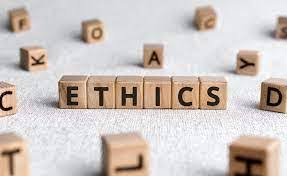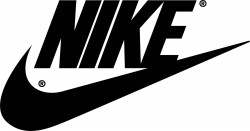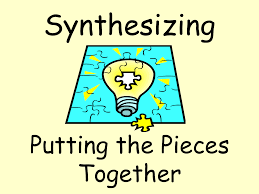
Unit 22: Using Information Ethically

Have you ever used outside sources in your research? How did you combine outside sources with your own ideas?
Day 1:
Vocabulary
Here are the vocabulary terms for this unit. By becoming familiar with these terms first, the reading samples will be easier to understand. Please review the terms and answer questions 1 – 9.
Plagiarism: the act of copying someone else’s work and saying it is your own
Unethical: dishonest, wrong
Common Knowledge: information that it’s safe to assume a large number of people know and understand
Trademark: a word, phrase, and/or symbol that belongs to a specific brand, company, or person
Copyright: the legal right to print, publish, perform, film, or record material and to allow others to do the same
Direct quote: a segment of a text that is copied word for word
Paraphrase: a rewording of something that was written or spoken by someone else
Summarize: to give a brief statement of the main points
Synthesize: to combine information and ideas in order to create something new, like a report
Let’s Practice
Day 2: Using Information Ethically
 |
When doing research, it is important to rewrite information from outside sources in order to avoid plagiarism. Plagiarism is taking another writer’s ideas and trying to pass them off as your own. Copying the work of someone else is unethical. Ask yourself the following questions to make sure you are using information ethically:
Plagiarism is a serious offense. In the workplace, employees can be fired for plagiarism. In some schools, plagiarism is ground for failing the assignment, failing the class, suspension, or expulsion.
So, how can you avoid plagiarism? The main way to avoid plagiarism is to cite your sources of information. When you site your sources, you include the name of the author of your source, along with additional information, like a page or paragraph number. You’ll learn more about citing your sources later in the course.
How do you know if the information you are including in your writing needs a citation? First, ask yourself if the information is considered common knowledge. Common knowledge is information that it’s safe to assume that a large number of people know and understand. For example, high school students and adults should know that the United States fought in World War II against Japan and Germany. This is considered common knowledge. However, it is not common knowledge that approximately 416,800 American soldiers died in World War II. If you were to include this information in a report, you would need to include a citation that explains where you got the information. Do you see the difference?
Here are a few more examples of common knowledge and information that would need to be cited:
| Common Knowledge | Citation Needed |
Dogs are popular pets. |
Retrievers are the most popular dog breed in 2022. |
Many people attended the original Woodstock music festival. |
Approximately 400,000 people attended Woodstock. |
The Titanic is a ship that sank on its first voyage. |
The Titanic weighed 52,310 tons. |
Information that is copyrighted or trademarked is also legally protected. If something is copyrighted, that means that it belongs to a person or company. You can identify the person or company by the trademark associated with the information. Even if you don’t realize it, you’re probably very familiar with trademarks and copyrighted information.
 |
The McDonald’s golden arches is an example of a trademark.
 |
Another example of a trademark is The font, the word “Nike,” and the “swoosh” are all trademarks.
An example of copyrighted information would be the lyrics to songs; this example can include popular songs by current artists, songs that appear in musicals, or even the happy birthday song. Have you ever noticed that when the staff in a restaurant celebrates a customer’s birthday, they don’t sing what you might consider to be the traditional happy birthday song? This is because for a long time, a company called Warner Chappell Music owned the rights to the song.
Two other ways to avoid plagiarism are paraphrasing and summarizing. When you paraphrase, you reword something that has been said or written by someone else. When you summarize, you only write the key points. You still need to site your sources, even if you paraphrase or summarize.
Day 3: Synthesizing Information
 |
When you write a report, you want to include a variety of information. You want to have an even mix of direct quotes, summarizing, paraphrasing, and your own unique ideas. You also want to use multiple sources of information. In order to do this, you will need to synthesize the information. Synthesizing means that you are combining many different sources into information into a new product, such as a report of documentary.
You may not realize it, but you synthesize information frequently. When you work with others in a group, you synthesize when you brainstorm, make group decisions, solve problems, and complete assignments. When you synthesize, follow these steps:
Imagine your teacher divided you into groups with other classmates. Within your group, you’re given a discussion question, such as “should cell phones be used in school?” You and the members of your group discuss your opinions about the topic, and one member of the group will share out when the discussion time is over. When this group member speaks, they combine the ideas of the group into new, unique statements. This is synthesizing.
Step 1: Gather information and ideas – If you are in a discussion group, take notes on everyone’s ideas. If you are researching a topic, take notes on main points.
Step 2: Look for similarities - Find ideas that are alike as well as ideas that are repeated. They will help you decide what ideas are key points on which you should focus.
Step 3: Combine and build on key points - In your own words, combine the key points and try to build on them. Let other people’s ideas spark new ideas of your own.
Day 4 and 5:
1. Look over your work and submit it to your teacher.
2. Complete the "Let's Practice" activities included in the Unit Resources folder.
3. Redo any questions sent back to you by your teacher.